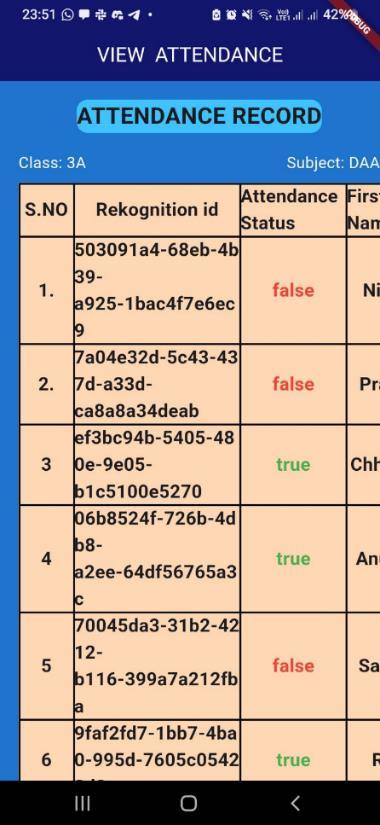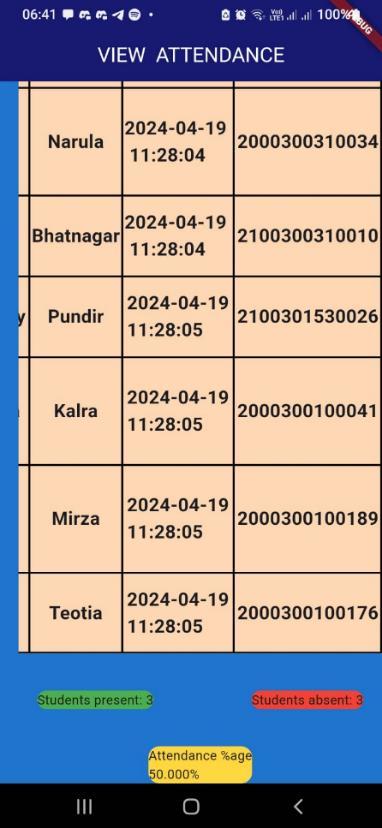
International Research Journal of Engineering and Technology (IRJET) e-ISSN: 2395-0056
Volume: 11 Issue: 04 | Apr 2024 www.irjet.net p-ISSN: 2395-0072
SMART CAMPUS: SMART ATTENDANCE MANAGEMENT SYSTEM USING FACE RECOGNITION
Anushka Kalra1 , Reva Teotia2 , Sanskriti Mamgain3, Abhishek Singh4
1Student, Dept. of Computer Science and Engineering, Inderprastha Engineering College, Uttar Pradesh, India
2Student, Dept. of Computer Science and Engineering, Inderprastha Engineering College, Uttar Pradesh, India
3Student, Dept. of Computer Science and Engineering, Inderprastha Engineering College, Uttar Pradesh, India
4Student, Dept. of Computer Science and Engineering(AIML), Inderprastha Engineering College, Uttar Pradesh, India
Abstract - : This research introduces a revolutionary way of attendance management based on facial recognition technology. The solution uses Amazon Rekognition, a highly accurate and scalable service, to automate attendance recordinginreal-time.Facesarespottedandrecognizedfrom live images, removing the need for manual attendance recording. This abstract outlines the project's core characteristics,includingprecisefacialrecognition,real-time attendance tracking, scalability, security, and increased efficiency. The project highlights the efficiency of facial recognitiontechnologyinattendancemanagement,providing a strong and dependable solution for a variety of institutions and organizations.
Key Words: Attendance, Amazon Rekognition, Amazon Web Services, facial recognition, face
1.INTRODUCTION
Attendance management continues to be a critical component of corporate and educational environments, assuringresponsibilityandefficiency.Traditionalsolutions, suchasmanualrecordingorswipecards,haveprovencostly and susceptible to errors. In response to these issues, present-day technology presents a viable solution: facial recognition.
The evolution of attendance systems has seen a shift towards automation, with AI (Artificial Intelligence) and facial recognition technology leading the charge. Facial recognition, enabled by modern algorithms and machine learning, has transformed how we track attendance. By analyzinguniquefacialfeatures,suchsystemscanaccurately identify individuals in real time, eliminating the need for manualinputandreducingtheriskoferrorsandfraudulent practicessuchasproxyattendance.
The project "Smart Attendance System Using Face Recognition" proposes a ground-breaking approach for streamlining attendance monitoring operations by incorporating facial recognition technology. This system, which has been developed using Amazon Rekognition, a
cutting-edgeAI-poweredpictureandvideoanalysistool,has thepotentialtorevolutionizeattendancemanagement.
Attendance systems have evolved dramatically, moving frommanualtoautomatedsolutions.Withbreakthroughsin Artificial Intelligence and facial recognition technologies, attendancemonitoringhasreachednewlevelsofefficiency and precision. AI-powered technologies, such as Amazon Rekognition, have emerged as game changers, providing unprecedented capabilities in facial recognition and biometricidentification.
By harnessing the power of AI and facial recognition technology,theSmartAttendanceSystemaimstoautomate the attendance tracking process, eliminating the need for manual intervention and reducing administrative burden. This project represents a significant leap forward in attendancemanagement,promisingreal-time,accurate,and efficienttrackingacrossdiverseorganizationalsettings.
Insummary,thisprojectrepresentsapioneeringeffortin the field of attendance management, leveraging the latest advancements in AI and facial recognition technology. ThroughtheintegrationofAmazonRekognition,thesystem endeavourstorevolutionizetraditionalattendancetracking methodologies, offering a more efficient, accurate, and reliablesolutionforvariousorganizationalsettings.
2.PROJECT REQUIREMENTS
Theautomaticattendancemarkingsystemmakestracking attendanceeasierbyutilizingfacialrecognitiontechnology. ItmakesuseofseveralAWS(AmazonWebService)services, such as DynamoDB for database management, Simple StorageService(S3)forstorage,andAmazonRekognition for facial analysis.Flutter and React are used in front-end development to provide an intuitive user interface for systeminteraction

International Research Journal of Engineering and Technology (IRJET) e-ISSN: 2395-0056
Volume: 11 Issue: 04 | Apr 2024 www.irjet.net p-ISSN: 2395-0072
2.1 Technologies Involved
Tobuildthissystem,thefollowingtechnologieshavebeen used:
2.1.1 Amazon Web Services Technologies
Amazon Rekognition: AmazonRekognitionisacutting edge service that analyzes images and videos using deep learning. It has features such as facial recognition, object detection,andmore.AmazonRekognitioniscriticaltothis project's ability to automatically mark attendance. It accomplishesthisbyrecognizingandevaluatingfacesinrealtimeandthencomparingthemtoapre-definedsetoffaces storedinacollection.Theprogramalsoreturnscrucialfacial traits that aid in identity confirmation and, as a result, promoteproperattendancemarking.
Amazon S3: Amazon S3 is a dependable and highly scalable object storage solution. Amazon S3 is used in this project for a variety of reasons. It provides a centralized repositoryfortheproject'sfacialrecognitionrequirements bystoringstudentphotosandfacialdataforlateruse.Italso aids in the management of these image sets, which are essentialtothefacialrecognitionprocedure.Thedataneeded fortheautomatedattendancemarkingsystemiscontinuous and secure because of Amazon S3's redundancy and durability, which guarantee that all stored data is safeguardedagainstloss.
Amazon DynamoDB: A fully-managed No Structured Query Language (NoSQL) database service designed for scalability and high availability is Amazon DynamoDB. DynamoDBisessentialtoourprojectsinceitsupportsthe automated attendance marking system. It forms the foundation of the system's data structure by storing vital studentdatasuchasnames,studentidentifications(IDs),and faceIDs.Additionally,theservicekeepstrackofattendance logs, recording pertinent data such as student IDs and timestamps. Front-end apps can retrieve data quickly because of the data structure and strong storage, which makesiteasiertointegrateandinteractwiththedatainreal time.DynamoDB'sscalabilityandhighavailabilityenablethe system to manage growing loads and guarantee steady performance.
Amazon Application Programming Interface (API) Gateway: AmazonAPIGatewayisa fully managedservice thatmakesiteasyfordeveloperstocreate,publish,maintain, monitor, and secure APIs at any scale. With API Gateway, developers can effortlessly craft Representational State Transfer(RESTful)APIsandWebSocketAPIs,enablingthe development of real-time, bidirectional communication applications. API Gateway supports containerized and serverlessworkloads,aswellaswebapplications.Itsbenefits includeefficientAPIdevelopment,performanceatanyscale,
cost savings at scale, easy monitoring, flexible security controlsandRESTfulAPIoptions.
Amazon CloudWatch: AmazonCloudWatchisaservice thatmonitorsapplications,respondstoperformancechanges, optimizesresourceutilization,andoffersoperationalhealth information.CloudWatchprovidesvisibilityintosystem-wide performancebygatheringdataacrossAWSservices.Italso allows users to trigger alarms, automatically respond to changes, and receive a consolidated picture of operational health.
Amazon Lambda function: AWS Lambda is an eventdriven,serverlesscomputingplatformprovidedbyAmazon aspartofAmazonWebServices.Itletsdevelopersruncode withouthavingtosetupormanageservers.Itexecutescode in response to events and automatically manages the computer resources needed for the function. It supports many programming languages and may be activated by a variety of AWS services or Hypertext Transfer Protocol (HTTP) requests, making it perfect for developing eventdrivenandmicroservicessystems.
Amazon Amplify: AWS Amplify is a set of tools and services that make it simple for developers to create and launchappsonAWS.Itincludescodelibraries,ready-to-use components, and a built-in Command Line Interface (CLI). AWSAmplifyfeaturesadiversesetofopen-sourcelibraries and drag-and-drop User Interface (UI) components that developerscanutilizeasbuildingblocksfortheirapps.The frameworkiscompatiblewithiOS,Android,Web,andReact Nativemobileapps,aswellasReact,Ionic,Angular,andvue.js webapplications.
2.1.2 Software Requirements
Flutter: FlutterUIframeworkisanopen-sourcesoftware development kit created by Google to facilitate the developmentofcross-platformapplications.Thisprojectuses Fluttertocreatethemobileapplicationthatwillbeusedby administrators and students to access and manage the attendancesystem.Theframework'suser-friendlyinterface makesitsimpleforuserstocheckattendancerecordsand related data. Flutter's ability to support numerous platforms including iOS and Android using a single codebaseisamajoradvantage.Thismakesdevelopmentand maintenance easier while guaranteeing a consistent user experienceacrossvariousdevices.
React: React is a JavaScript package used to create dynamic user interfaces, mostly for online applications. In this project,Reactisused tocreatea web-based front-end thatismostlyusedforadministrativedutiesandmonitoring. React'spowerfulcapabilitiesenablereal-timedataupdates fromback-endservices,allowingadministratorstostayupto current on attendance status and other key information without having to manually reload the page. In addition,

International Research Journal of Engineering and Technology (IRJET) e-ISSN: 2395-0056
Volume: 11 Issue: 04 | Apr 2024 www.irjet.net p-ISSN: 2395-0072
React provides an interactive user experience, making attendance system management easier and allowing administratorstoworkmoreefficiently.Thismixofreal-time interactivityandeaseofusemakesReactanexcellentchoice fordevelopingtheproject'sfront-endcomponents.
2.2 Hardware Requirements
Althoughthisproject'sprimaryfocusisonsoftwareand cloud-based services, certain hardware components are required for its operation. Cameras are required to take photographs of students, which are then analyzed by AmazonRekognitionforfacialrecognitionandattendance monitoring.Usersmustalsohaveasmartphoneortabletto engagewiththeFlutter-basedsoftware,whichallowsthem tomonitorattendancedataandcontrolrelevantinformation. AdministratorsrequirePersonalComputers(PCs)toaccess the React-based web application, which allows them to manage the system, track attendance, and conduct other administrativeactivities.Thesephysicalcomponentswork together with the software and cloud infrastructure to provideastreamlinedandfunctioningattendancemarking system.
2.3 Other Requirements
Security and Privacy: Since this project involves facial recognition and the handling of sensitive personal data, implementing robust security and privacy measures is crucial.AlldatastoredinAmazonS3andDynamoDBmust be encrypted to ensure confidentiality and prevent unauthorized access. Additionally, the project must implementstrictauthenticationandauthorizationprotocols for users accessing the mobile app and the web-based application, ensuring that only authorized personnel can interactwithsensitivedata.Compliancewithrelevantdata protection laws and regulations, such as the General Data Protection Regulation (GDPR) or Central Consumer ProtectionAuthority(CCPA),isalsoessentialtoprotectuser privacyandmaintainethicalstandards.Thesesecurityand privacymeasurescreateasecureframeworkfortheproject, safeguardinguserdatawhileallowingtheattendancesystem tofunctioneffectively.
3.DESIGN AND IMPLEMENTATION
3.1
Proposed Methodology
1. Requirement Analysis: Conduct a comprehensive analysis of the requirements and objectives of the Smart Attendance System using Face Recognition project and identify key functionalities, user roles, technologies, integration points with AWS services and frontend frameworksalongwiththedeadlines.
2. Technology selection: Choose appropriate technologies for frontend and backend development after
careful assessment of viable options. AWS services were preferredforthebackendduetotheiraccuracy,securityand privacy.Forthefront-end, FlutterandReactwerechosenfor themobileapplicationandwebapplicationrespectively.
3. System Architecture and Design: Draft a general architecture of the system based on the objectives of the projectinsuchawaythatitdefinestheinteractionbetween AWS services, frontend frameworks, and the database. Design Unified Modeling Language (UML) diagrams to understanduserflowanddataflow.
4. AWSSetupandConfiguration:Theprojectrequires AWSservicesforimplementation.Therefore,thecreationof an AWS account, and setting up of IAM users, roles and permissions is the primary step. Post the setup of the account,itisessentialtoinstallandsetupAWSCLIandAWS SDK (Software Development Kit) as per application requirements.
5. Setup AWS Resources and Services: Set up and configureAWSservices,includingcreatingLambdafunctions for backend logic, setting up S3 buckets for storage, configuring DynamoDB tables for data persistence, implementing API Gateway endpoints for communication, and integrating CloudWatch for monitoring. Integrate AmazonRekognitionforfacialrecognitioncapabilities.
6. FrontendDevelopment:Developtheuserinterfaces forthemobileandwebapplicationsusingFlutterandReact, respectively. Implement features for attendance tracking, studentassistanceresources,anduserauthentication.
7. APIDevelopment:DesignandimplementHTTPAPIs using API Gateway to enable communication between the frontendapplicationsandbackendservices.
8. Testing:Conductthoroughtestingofthesystemto ensurefunctionality,performance,andsecurity.
9. DeploymentandMonitoring: Deploythesystemto AWSinfrastructureusingAmplifyforfrontenddeployment andAWSCLIforbackenddeployment.Setupmonitoringand alertingusingCloudWatchtotracksystemperformanceand respondtoanyanomalies.
10. Documentation: Create comprehensive documentationincludingreports,reviewpaperandresearch paperthatoutlinetheproject.

International Research Journal of Engineering and Technology (IRJET) e-ISSN: 2395-0056
Volume: 11 Issue: 04 | Apr 2024 www.irjet.net p-ISSN: 2395-0072
3.2 General Architecture

Fig -1:ArchitectureofFacialRecognition-based AttendanceSystem
Figure 1 demonstrates the architecture used to set up AWS(AmazonWebServices)toolsandservicestobuildthe facial attendance system. The AWS services include S3 bucket, Lambda function, Amazon Rekognition, Amplify, DynamoDB and API Gateway. The S3 buckets are used to store images, the lambda function includes the code to retrieveandprocessthedata.TheDynamoDBstoresstudent data along with the attendance records that are later retrievedbythefrontendtechnologiesviaAPIgateway.
4.RESULTS
4.1 Brief Result
Theprojectsuccessfullyperformsautomatedattendance marking using face recognition technology. Each student, uponbeingrecognizedaccurately,ismarkedpresentandthe attendance timestamp is recorded to verify the data. The confidencescorefortherecognizedfacesisabove95which can be verified using the Amazon CloudWatch logs of the corresponding Lambda function. The application also incorporatescomprehensivestudentassistanceresources, extendingsupporttothestudentsbeyondcampus.



International Research Journal of Engineering and Technology (IRJET) e-ISSN: 2395-0056
Volume: 11 Issue: 04 | Apr 2024 www.irjet.net p-ISSN: 2395-0072

Figures2,3and4arehorizontallyscrollableanddepict theattendancerecordsofthestudentsintheformofatable.
4.3


Figures5and6depictsomeofthescreensfromweb applicationbuiltusingReact.
5. CONCLUSION
Inconclusion,thedevelopmentofthe"SmartAttendance SystemusingFaceRecognition"projectmarksasignificant milestone in the evolution of attendance tracking methodologies, particularly within educational and organizational contexts. The project has successfully developed a strong and all-inclusive attendance management solution by utilizing advanced technologies suchasAmazonRekognitionandnumerousAWSservices, includingLambda,S3,DynamoDB,Amplify,CloudWatch,and APIGateway,inconjunctionwithfrontendframeworkslike FlutterandReact.
Theintegrationoffacialrecognitiontechnologyenables real-time and accurate identification of individuals, eliminatingtheneedformanualattendanceprocessesand reducingadministrativeburden.UtilizingAWSservicesalso guarantees the system's scalability, dependability, and security, enabling seamless operation in a variety of organizationalsettings.
Moreover, the inclusion of comprehensive student assistance resources extends the functionality of the applicationbeyondattendancetracking,providingvaluable supportandresourcestostudentsbothonandoffcampus. Thisfeatureemphasizeshowcommittedtheinitiativeisto improvingstudentsuccessandtheeducationalprocessasa whole.
Toputitsimply,the"SmartAttendanceSystemusingFace Recognition"projectisanattempttosolvethedrawbacksof conventional attendance monitoring techniques by combining cutting-edge technologies with user-centric designprinciples.
6. FUTURE SCOPE
1. Geolocation Integration: Integratinggeolocation features into the attendance system can enable administrators to track the location of students or employeeswhentheymarktheirattendance.Thiscanhelp preventattendancefraudbyverifyingthatindividualsare physically present at the designated location during attendancemarking.
2. Cross-Institution Integration: Cross-institution integration allows multiple educational institutions or organizations to share attendance data securely and efficiently.Thiscanbeparticularlyusefulforstudentsor employees who belong to different institutions or departments and need to maintain a consolidated attendancerecord.

International Research Journal of Engineering and Technology (IRJET) e-ISSN: 2395-0056
Volume: 11 Issue: 04 | Apr 2024 www.irjet.net p-ISSN: 2395-0072
3. Feedback Mechanism: Implementing a feedback mechanismwithintheattendancesystemallowsstudentsor employees to provide feedback on their attendance experience.Thisfeedbackcanbeusedtoidentifyareasfor improvement, address concerns, and enhance user satisfactionwiththeattendancemarkingprocess.
4. Emotion Recognition: Integrating emotion recognition technology into the attendance system can providevaluableinsightsintotheemotionalstateofstudents oremployeesduringattendancemarking.Thisinformation canbeusedtoidentifypotentialissuesaffectingattendance and students in general, such as stress, anxiety, or disengagement, and take appropriate actions to address them.
REFERENCES
[1] Shyam Sunder Bahety, Kishan Kumar, VishwadeepTejaswi,SharadRBalagar,AnilBC, 2020,ImplementationofAutomatedAttendance System using Facial Identification from Deep Learning Convolutional Neural Networks, INTERNATIONAL JOURNAL OF ENGINEERING RESEARCH & TECHNOLOGY (IJERT) NCAIT –2020(Volume8–Issue15)
[2] Fenton, A., 2019. Automated Classroom AttendanceSystem(ACAS).
[3] T, Shalini, FACE RECOGNITION BASED ATTENDANCE SYSTEM USING CNN ARCHITECTURE (May 13, 2023). International Journal for Innovative Engineering & ManagementResearch,Forthcoming,Availableat SSRN:https://ssrn.com/abstract=4447364
[4] Miller, W.E., 2018. Utilizing Facial Recognition Software to Record Classroom Attendance (Doctoraldissertation,AuburnUniversity).
[5] “APIManagement-AmazonAPIGateway-AWS,” Amazon Web Services, Inc. https://aws.amazon.com/api-gateway/
[6] “Serverless Function, FAAS Serverless - AWS Lambda - AWS,” Amazon Web Services, Inc. https://aws.amazon.com/lambda/
[7] “IntroductiontoAmazonCloudWatch,”Amazon Web Services, Inc. [Online]. Available: https://aws.amazon.com/cloudwatch/
[8] Wikipedia contributors, “AWS Lambda,” Wikipedia, Apr. 17, 2024. https://en.wikipedia.org/wiki/AWS_Lambda
[9] B. Matador, “What is AWS Amplify?,” Blue Matador. https://www.bluematador.com/blog/what-isaws-amplify
[10] “Cloud Object Storage - Amazon S3 - AWS,” Amazon Web Services, Inc. https://aws.amazon.com/s3/
[11] “What is Amazon Rekognition? - Amazon Rekognition.” https://docs.aws.amazon.com/rekognition/latest /dg/what-is.html
[12] “Buildyourownfacerecognitionserviceusing Amazon Rekognition | Amazon Web Services,” Amazon Web Services, Jun. 24, 2021. https://aws.amazon.com/blogs/machinelearning/build-your-own-face-recognitionservice-using-amazon-rekognition/
[13] Ernchi,“GitHub-ernchi/aws-rekog-attendancesys:Facial recognition basedattendance taking system using AWS Rekognition.,” GitHub. https://github.com/ernchi/aws-rekogattendance-sys
[14] “Detecting and analyzing faces - Amazon Rekognition.” https://docs.aws.amazon.com/rekognition/latest /dg/faces.html
[15] Ayu, “Face recognition assessment (AWS Face Rekognition) - DSF Web Services EngineeringMedium,” Medium, Jan. 07, 2022. [Online]. Available: https://medium.com/dsfdevelopers/face-recognition-assessment-awsface-rekognition-15921d65b351
[16] “Fast NoSQL Key-Value Database – Amazon DynamoDB – Amazon Web Services,” Amazon Web Services, Inc. https://aws.amazon.com/dynamodb/
[17] C. Wen, “Serverless Deployment with Netlify Lambda (ReactJS FE + GraphQL BE),” Medium, Jan. 26, 2024. [Online]. Available: https://medium.com/@cheahwen1997/impleme nt-a-face-recognition-attendance-system-withface-api-js-946a1615236d
[18] M. Grover, “Face Recognition using Amazon Rekognition - Malvika Grover - Medium,” Medium, Oct. 07, 2023. [Online]. Available: https://medium.com/@grover.malvika1/facerecognition-using-amazon-rekognition42fb5fe27fee

International Research Journal of Engineering and Technology (IRJET) e-ISSN: 2395-0056
Volume: 11 Issue: 04 | Apr 2024 www.irjet.net p-ISSN: 2395-0072
[19] “ModuleThree-BuildaFlutterMobileAppusing AWSAmplify-Part1,”AmazonWebServices,Inc. https://aws.amazon.com/getting-started/handson/build-flutter-mobile-app-part-one/modulethree/
[20] MadMario,“Deploylambdausingserverless,” Flattered With Flutter, Apr. 05, 2022. https://flatteredwithflutter.com/deploy-lambdausing-serverless/
[21] MadMario,“DartonAWSlambda,”FlatteredWith Flutter, Nov. 03, 2021. https://flatteredwithflutter.com/dart-on-awslambda/
[22] Aws-Samples, “GitHub - aws-samples/amazonrekognition-code-samples:AmazonRekognition CodeSamples,”GitHub.https://github.com/awssamples/amazon-rekognition-code-samples
[23] S. Purkayastha, “Machine Learning Use Case: FacialRecognitionUsingAmazonRekognition–RadioStudio,” RadioStudio, Jan. 02, 2024. https://radiostud.io/machine-learning-use-casefacial-recognition-using-amazon-rekognition/
[24] G.SSanthoshKumar,MartinSiby,PhilsonKPhilip, Rajat Jaic Mendus, Shine Abraham. 2019. Facetrack : Smart Attendance System using Face Recognition. International Research Journal of EngineeringandTechnology(IRJET).06(05).
